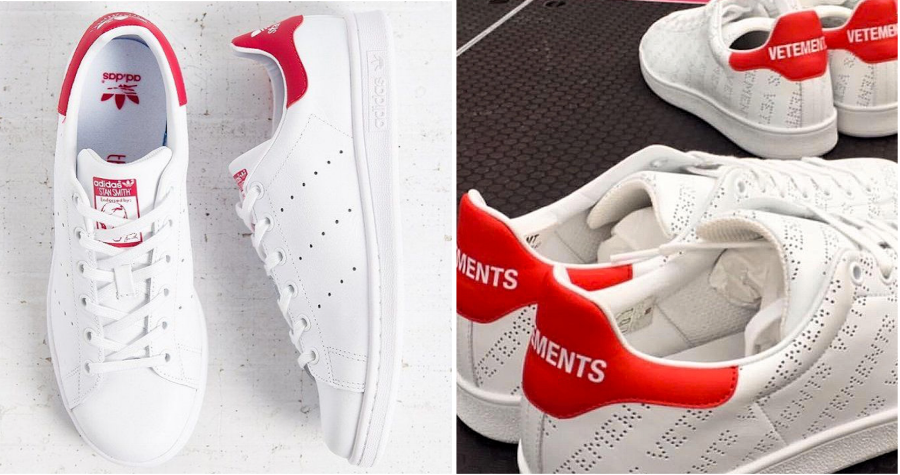Adidas has been on a tear over its famous three-stripe trademark, threatening, and in many cases filing (or causing the filing of) trademark infringement lawsuits with brands ranging from Marc Jacobs and Gucci to —Juicy Couture and Forever 21. The German sportswear giant has not been shy to enforce its other trademark (and trade dress) rights either, including those that come hand-in-hand with its iconic Stan Smith sneaker. With a lookalike shoe soon to be released by Vetements, it is an apt time to look at what rights Adidas has in its most famous silhouette and whether or not Demna Gvasalia and co. should be expecting a cease and desist letter.
The Stan Smith shoe was first released in 1965, but it has relatively recently taken the fashion industry by storm, thanks to endorsements from Celine’s Phoebe Philo, adidas’ collaborations with Raf Simons, Pharrell, and Alexander Wang, and a widespread adoption by the fashion industry in general.
A technical look at the design reveals that that the Stan Smith has what adidas refers to as a “classic tennis shoe profile.” The design elements typically consist of the following: A sleek upper, which consists of a thin tongue and seven rows of laces; three rows of angled perforations adorn the outer side of each shoe; there is defining stitching on each side that frames the perforations (the stitching comes to a point on the side of the shoe, above the midsole; also on the side, towards the toe, the stitching make up a small rectangular box; there is a prominent, “mustache-shaped” heel tab, which tends to contrast in color with the body of the shoe itself; and the sole of the shoe consists of a particularly flat rubber outsole.
According to the Adidas America v. Payless Shoes case, which was decided in 2008 in the U.S. District Court for the District of Oregon, “Adidas first introduced the Superstar Trade Dress in 1969 and its principle features have not changed since that time. It consists of: (1) three parallel stripes (i.e., the Three—Stripe Mark) on the side of the shoe parallel to equidistant small holes; (2) a rubber ‘shell toe’; (3) a particularly flat sole; and (4) a colored portion on the outer back heel that identifies the shoes as Adidas’ brand.”
These four elements come together to make up the brand’s legally-protected “Superstar Trade Dress,” and gives adidas the right to sue other brands that are utilizing such a design without authorization. Having established that adidas has exclusive rights in several of design elements that make up the Vetements sneaker, the question is: Does that mean that adidas automatically has an open-and-shut case for trade dress infringement? And that answer is a solid no.

adidas’ Stan Smith (left) & Vetements’ sneaker (right)
While the two brands’ sneakers undoubtedly look alike, they do not appear to come from an official collab with adidas (at least not from info tied to the impending footwear), despite Vetements’ recent partnership with adidas-owned Reebok for footwear. And the visual similarity between the Stan Smith and Vetements’ new sneakers has not been lost on anyone (including the perennially sneaker-abreast folks over at Highsnobiety, who called the Vetements’ sneaker “eerily similar to adidas’ iconic Stan Smith tennis shoe”), but there is something even bigger at play here.
Stay with me for a moment …
In order for a party to prevail in a trade dress (or trademark) infringement case, it must also show that due to the allegedly infringing trade dress (or trademark) use, consumers are likely to be confused as to the source of the allegedly infringing goods.
In plain English: Are consumers going to be unsure about who was involved in the creation of the allegedly infringing goods, – i.e., the Vetements sneakers. Of interest for us is the fact that this notion of “confusion” firmly includes consumers erroneously thinking that a collaboration exists or that the rights holder (adidas here) authorized the alleged infringer (Vetements) to use its intellectual property.
In addition to the rise of collaborations in fashion in general as of late, this is a particularly damning element for Vetements, since the brand has become rather well-known for its widespread collaborations. You may recall the DHL gear or the 18 different brands that Vetements collaborated with for its Spring/Summer 2017 collection, including Juicy Couture, Levi’s, Hanes, Reebok, Brioni, and Manolo Blahnik.
With this in mind, it would not be a stretch – at allllll – given Vetements’ history of collaborations, adidas’ history of collaborations and the fashion industry’s general penchant for collaborations for consumers to think that Vetements’ Stan Smith-looking sneakers are the result of a collaboration between the buzzy brand and the German sportswear giant, and thereby, very likely give rise to a merited claim of trade dress infringement.
The question that remains: Will adidas sue?







